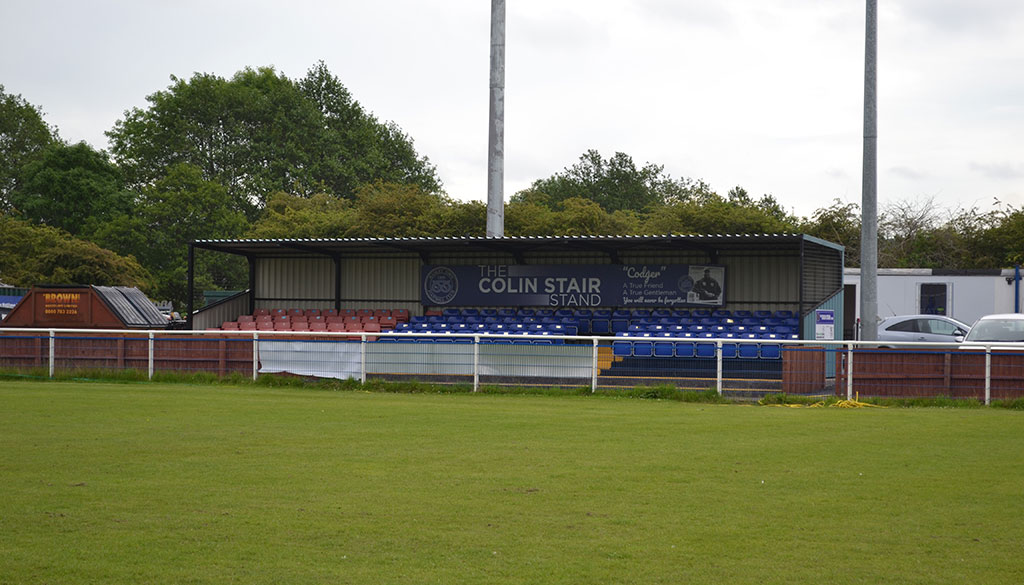
Emblematically Speaking - Hanley Town
Tue 5th December 2017 | Hanley Town | By Stewart Taylor
This week we have a look at another club emblem and, at first glance, there doesn’t seem a lot to say; but there is!
The emblem is, perhaps, simplicity itself, establishing that the emblem represents a football club by giving the name, and the initials of the football club.
It also shows the date of formation. So far, all so straightforward but the mystery, intrigue and debating points come from the device in the centre; a coiled rope.
Natives of the County of Staffordshire will likely know what the rope represents as it is known as the Stafford Knot – not the Staffordshire Knot as it is sometimes, erroneously, referred to.
The Knot appears as an emblem of the County on many badges representing a diverse range of Staffordshire based institutions. Amongst these are the County Coat of Arms, the Staffordshire police and fire and rescue services, the Universities of Keele and Staffordshire.
In the military the Knot forms part of the insignia of the North Staffordshire Regiment, the South Staffordshire Regiment, the Staffordshire Regiment and currently is the arm badge of the Mercian Regiment. The Knot also appears on road signs on the entry points to the County.
In football we see the Knot still used on the emblem of one of the three professional clubs to play in the County namely Port Vale. The Knot was on early designs of the Stoke City emblem but has now disappeared in favour of a somewhat streamlined, modern, emblem.
So we now know what the device is and how it is used, but we have yet to explore the origins of the Stafford Knot, and here we get to the intriguing bit in that, as with many ancient devices, the origins are disputed. We can look in a little detail at two of them.
One of the most popular stories of the knot originated following the sentencing of three criminals to death by hanging in Stafford. However, when the executioner arrived to commit the grisly task, he came across a problem.
He only had one piece of rope. He could not just hang one of the criminals, and it would be unfair to the other two to give precedence to only one of the condemned.
He therefore tied his single rope into three loops and dispatched of all three criminals at the same time.
Another story of the knot stems from the motto of Staffordshire: "The Knot Unites".
The knot was said to symbolically bind three different local areas which joined to form what is now known as Staffordshire.
A more detailed account tells us of Ethelfleda, eldest daughter of Alfred the Great, who, more than a thousand years ago, defended a stronghold at Stafford.
She symbolically took off her girdle and said to the local lords: "With this girdle, I bind us all as one", and the three areas became Staffordshire.
The anniversary of this event was celebrated in 1913, a thousand years after it was said to have happened.
Nice stories - but is either of them the real story?
There's evidence to suggest that neither represent the true origin of the Knot, and that it comes from its presence on an Anglo-Saxon cross in a churchyard in Stoke-upon-Trent, and also on a 7th-century Anglo-Saxon object from the Staffordshire hoard.
This strongly suggests it pre-dates the Norman and medieval period, being probably either a heraldic symbol of early Mercia or a Celtic Christian symbol brought to Staffordshire by missionary monks from Lindisfarne.
As ever, the reader is invited to take their own preference as to the origins but any reference to the local de Stafford family will probably not help to define the origins of the Knot even though it is prominent on the family Coat of Arms. Equally, the resemblance to a pretzel is probably purely coincidental.
And there we have it. An elegant emblem which proudly places what is clearly a football club in the County of Staffordshire by the use of a single, powerful, device.
 Emblematically Speaking - Hanley Town
Emblematically Speaking - Hanley Town
Tue 5th December 2017 | Hanley Town
By Stewart Taylor

This week we have a look at another club emblem and, at first glance, there doesn’t seem a lot to say; but there is!
The emblem is, perhaps, simplicity itself, establishing that the emblem represents a football club by giving the name, and the initials of the football club.
It also shows the date of formation. So far, all so straightforward but the mystery, intrigue and debating points come from the device in the centre; a coiled rope.
Natives of the County of Staffordshire will likely know what the rope represents as it is known as the Stafford Knot – not the Staffordshire Knot as it is sometimes, erroneously, referred to.
The Knot appears as an emblem of the County on many badges representing a diverse range of Staffordshire based institutions. Amongst these are the County Coat of Arms, the Staffordshire police and fire and rescue services, the Universities of Keele and Staffordshire.
In the military the Knot forms part of the insignia of the North Staffordshire Regiment, the South Staffordshire Regiment, the Staffordshire Regiment and currently is the arm badge of the Mercian Regiment. The Knot also appears on road signs on the entry points to the County.
In football we see the Knot still used on the emblem of one of the three professional clubs to play in the County namely Port Vale. The Knot was on early designs of the Stoke City emblem but has now disappeared in favour of a somewhat streamlined, modern, emblem.
So we now know what the device is and how it is used, but we have yet to explore the origins of the Stafford Knot, and here we get to the intriguing bit in that, as with many ancient devices, the origins are disputed. We can look in a little detail at two of them.
One of the most popular stories of the knot originated following the sentencing of three criminals to death by hanging in Stafford. However, when the executioner arrived to commit the grisly task, he came across a problem.
He only had one piece of rope. He could not just hang one of the criminals, and it would be unfair to the other two to give precedence to only one of the condemned.
He therefore tied his single rope into three loops and dispatched of all three criminals at the same time.
Another story of the knot stems from the motto of Staffordshire: "The Knot Unites".
The knot was said to symbolically bind three different local areas which joined to form what is now known as Staffordshire.
A more detailed account tells us of Ethelfleda, eldest daughter of Alfred the Great, who, more than a thousand years ago, defended a stronghold at Stafford.
She symbolically took off her girdle and said to the local lords: "With this girdle, I bind us all as one", and the three areas became Staffordshire.
The anniversary of this event was celebrated in 1913, a thousand years after it was said to have happened.
Nice stories - but is either of them the real story?
There's evidence to suggest that neither represent the true origin of the Knot, and that it comes from its presence on an Anglo-Saxon cross in a churchyard in Stoke-upon-Trent, and also on a 7th-century Anglo-Saxon object from the Staffordshire hoard.
This strongly suggests it pre-dates the Norman and medieval period, being probably either a heraldic symbol of early Mercia or a Celtic Christian symbol brought to Staffordshire by missionary monks from Lindisfarne.
As ever, the reader is invited to take their own preference as to the origins but any reference to the local de Stafford family will probably not help to define the origins of the Knot even though it is prominent on the family Coat of Arms. Equally, the resemblance to a pretzel is probably purely coincidental.
And there we have it. An elegant emblem which proudly places what is clearly a football club in the County of Staffordshire by the use of a single, powerful, device.


